Financial Management Report: Morrison Supermarkets PLC Analysis
VerifiedAdded on 2023/01/11
|20
|5310
|54
Report
AI Summary
This report delves into the principles of financial management, encompassing decision-making processes, fraud detection and prevention techniques, and ethical considerations. It explores various approaches to decision-making, including knowledge-based, formal, and informal methods, along with the role of stakeholders. The report analyzes the importance of management accounting techniques, such as budgetary control and standard costing, in effective cost control and maximizing shareholder value. Furthermore, it examines techniques for fraud detection and prevention, emphasizing the significance of ethical decision-making within organizations. The report also includes a financial ratio analysis of Morrison Supermarkets PLC, evaluating its performance over three years and applying the data obtained in decision-making processes. It concludes with recommendations to improve financial sustainability and long-term growth.
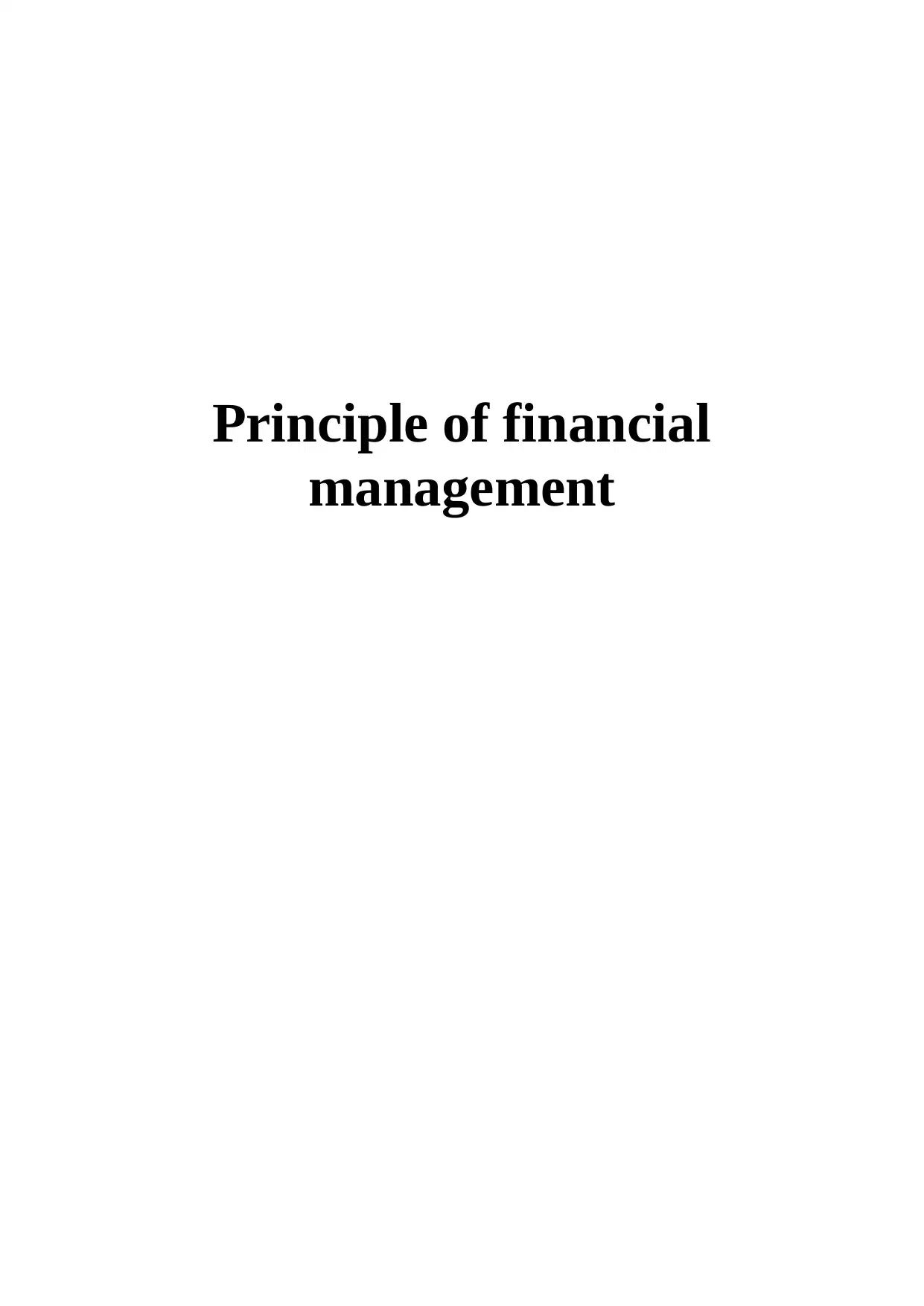
Principle of financial
management
management
Paraphrase This Document
Need a fresh take? Get an instant paraphrase of this document with our AI Paraphraser
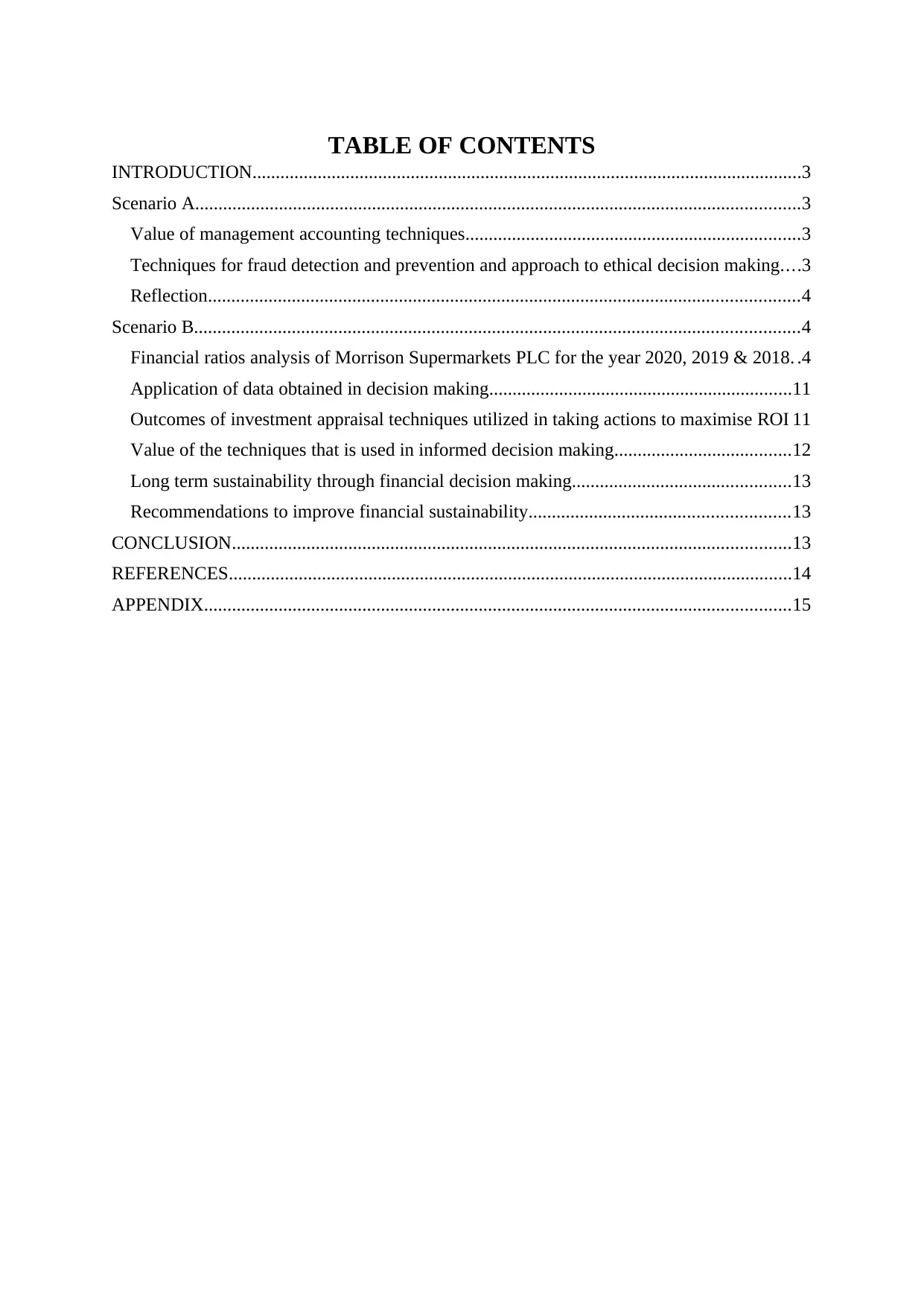
TABLE OF CONTENTS
INTRODUCTION......................................................................................................................3
Scenario A..................................................................................................................................3
Value of management accounting techniques........................................................................3
Techniques for fraud detection and prevention and approach to ethical decision making....3
Reflection...............................................................................................................................4
Scenario B..................................................................................................................................4
Financial ratios analysis of Morrison Supermarkets PLC for the year 2020, 2019 & 2018. .4
Application of data obtained in decision making.................................................................11
Outcomes of investment appraisal techniques utilized in taking actions to maximise ROI 11
Value of the techniques that is used in informed decision making......................................12
Long term sustainability through financial decision making...............................................13
Recommendations to improve financial sustainability........................................................13
CONCLUSION........................................................................................................................13
REFERENCES.........................................................................................................................14
APPENDIX..............................................................................................................................15
INTRODUCTION......................................................................................................................3
Scenario A..................................................................................................................................3
Value of management accounting techniques........................................................................3
Techniques for fraud detection and prevention and approach to ethical decision making....3
Reflection...............................................................................................................................4
Scenario B..................................................................................................................................4
Financial ratios analysis of Morrison Supermarkets PLC for the year 2020, 2019 & 2018. .4
Application of data obtained in decision making.................................................................11
Outcomes of investment appraisal techniques utilized in taking actions to maximise ROI 11
Value of the techniques that is used in informed decision making......................................12
Long term sustainability through financial decision making...............................................13
Recommendations to improve financial sustainability........................................................13
CONCLUSION........................................................................................................................13
REFERENCES.........................................................................................................................14
APPENDIX..............................................................................................................................15
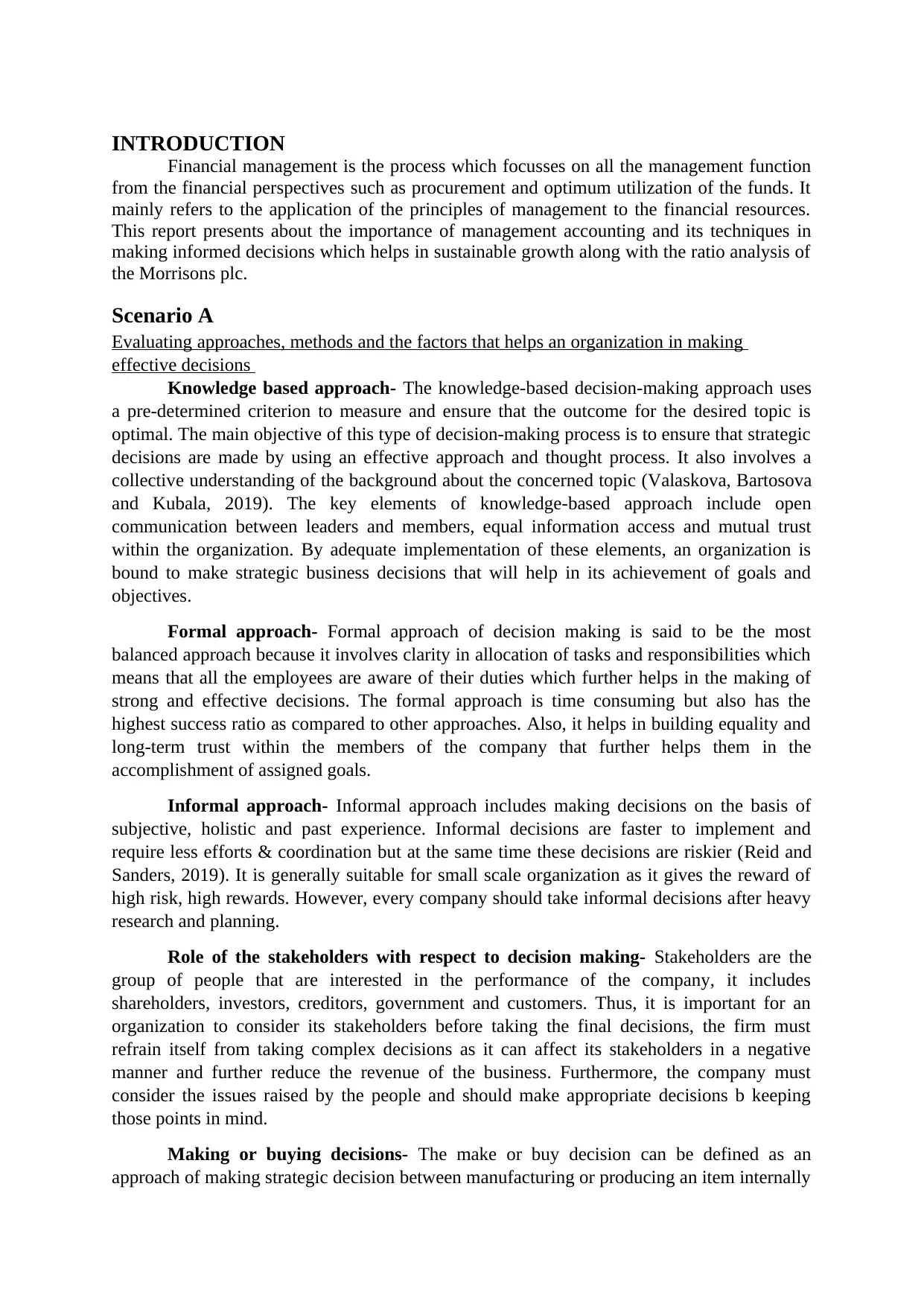
INTRODUCTION
Financial management is the process which focusses on all the management function
from the financial perspectives such as procurement and optimum utilization of the funds. It
mainly refers to the application of the principles of management to the financial resources.
This report presents about the importance of management accounting and its techniques in
making informed decisions which helps in sustainable growth along with the ratio analysis of
the Morrisons plc.
Scenario A
Evaluating approaches, methods and the factors that helps an organization in making
effective decisions
Knowledge based approach- The knowledge-based decision-making approach uses
a pre-determined criterion to measure and ensure that the outcome for the desired topic is
optimal. The main objective of this type of decision-making process is to ensure that strategic
decisions are made by using an effective approach and thought process. It also involves a
collective understanding of the background about the concerned topic (Valaskova, Bartosova
and Kubala, 2019). The key elements of knowledge-based approach include open
communication between leaders and members, equal information access and mutual trust
within the organization. By adequate implementation of these elements, an organization is
bound to make strategic business decisions that will help in its achievement of goals and
objectives.
Formal approach- Formal approach of decision making is said to be the most
balanced approach because it involves clarity in allocation of tasks and responsibilities which
means that all the employees are aware of their duties which further helps in the making of
strong and effective decisions. The formal approach is time consuming but also has the
highest success ratio as compared to other approaches. Also, it helps in building equality and
long-term trust within the members of the company that further helps them in the
accomplishment of assigned goals.
Informal approach- Informal approach includes making decisions on the basis of
subjective, holistic and past experience. Informal decisions are faster to implement and
require less efforts & coordination but at the same time these decisions are riskier (Reid and
Sanders, 2019). It is generally suitable for small scale organization as it gives the reward of
high risk, high rewards. However, every company should take informal decisions after heavy
research and planning.
Role of the stakeholders with respect to decision making- Stakeholders are the
group of people that are interested in the performance of the company, it includes
shareholders, investors, creditors, government and customers. Thus, it is important for an
organization to consider its stakeholders before taking the final decisions, the firm must
refrain itself from taking complex decisions as it can affect its stakeholders in a negative
manner and further reduce the revenue of the business. Furthermore, the company must
consider the issues raised by the people and should make appropriate decisions b keeping
those points in mind.
Making or buying decisions- The make or buy decision can be defined as an
approach of making strategic decision between manufacturing or producing an item internally
Financial management is the process which focusses on all the management function
from the financial perspectives such as procurement and optimum utilization of the funds. It
mainly refers to the application of the principles of management to the financial resources.
This report presents about the importance of management accounting and its techniques in
making informed decisions which helps in sustainable growth along with the ratio analysis of
the Morrisons plc.
Scenario A
Evaluating approaches, methods and the factors that helps an organization in making
effective decisions
Knowledge based approach- The knowledge-based decision-making approach uses
a pre-determined criterion to measure and ensure that the outcome for the desired topic is
optimal. The main objective of this type of decision-making process is to ensure that strategic
decisions are made by using an effective approach and thought process. It also involves a
collective understanding of the background about the concerned topic (Valaskova, Bartosova
and Kubala, 2019). The key elements of knowledge-based approach include open
communication between leaders and members, equal information access and mutual trust
within the organization. By adequate implementation of these elements, an organization is
bound to make strategic business decisions that will help in its achievement of goals and
objectives.
Formal approach- Formal approach of decision making is said to be the most
balanced approach because it involves clarity in allocation of tasks and responsibilities which
means that all the employees are aware of their duties which further helps in the making of
strong and effective decisions. The formal approach is time consuming but also has the
highest success ratio as compared to other approaches. Also, it helps in building equality and
long-term trust within the members of the company that further helps them in the
accomplishment of assigned goals.
Informal approach- Informal approach includes making decisions on the basis of
subjective, holistic and past experience. Informal decisions are faster to implement and
require less efforts & coordination but at the same time these decisions are riskier (Reid and
Sanders, 2019). It is generally suitable for small scale organization as it gives the reward of
high risk, high rewards. However, every company should take informal decisions after heavy
research and planning.
Role of the stakeholders with respect to decision making- Stakeholders are the
group of people that are interested in the performance of the company, it includes
shareholders, investors, creditors, government and customers. Thus, it is important for an
organization to consider its stakeholders before taking the final decisions, the firm must
refrain itself from taking complex decisions as it can affect its stakeholders in a negative
manner and further reduce the revenue of the business. Furthermore, the company must
consider the issues raised by the people and should make appropriate decisions b keeping
those points in mind.
Making or buying decisions- The make or buy decision can be defined as an
approach of making strategic decision between manufacturing or producing an item internally
⊘ This is a preview!⊘
Do you want full access?
Subscribe today to unlock all pages.

Trusted by 1+ million students worldwide
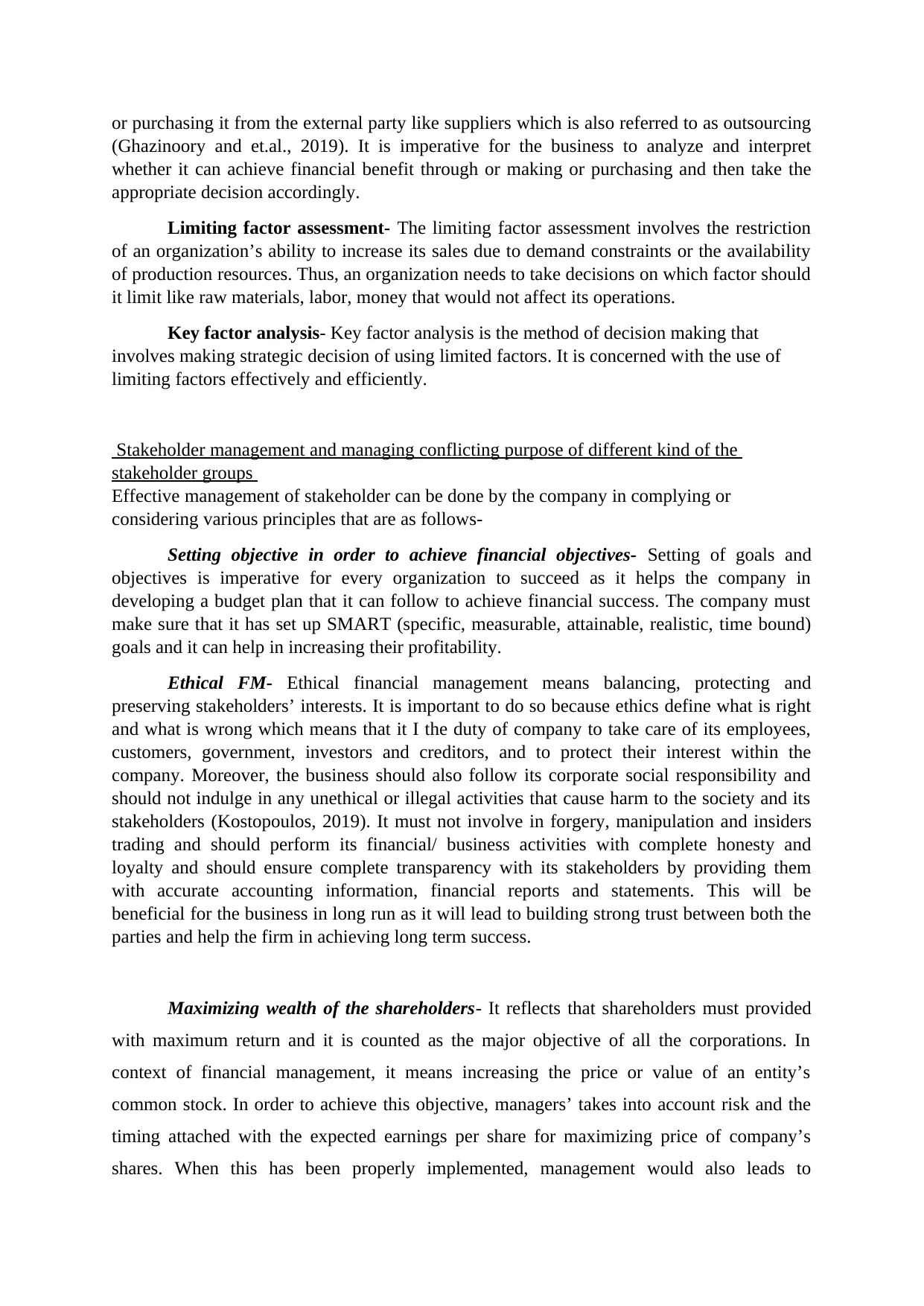
or purchasing it from the external party like suppliers which is also referred to as outsourcing
(Ghazinoory and et.al., 2019). It is imperative for the business to analyze and interpret
whether it can achieve financial benefit through or making or purchasing and then take the
appropriate decision accordingly.
Limiting factor assessment- The limiting factor assessment involves the restriction
of an organization’s ability to increase its sales due to demand constraints or the availability
of production resources. Thus, an organization needs to take decisions on which factor should
it limit like raw materials, labor, money that would not affect its operations.
Key factor analysis- Key factor analysis is the method of decision making that
involves making strategic decision of using limited factors. It is concerned with the use of
limiting factors effectively and efficiently.
Stakeholder management and managing conflicting purpose of different kind of the
stakeholder groups
Effective management of stakeholder can be done by the company in complying or
considering various principles that are as follows-
Setting objective in order to achieve financial objectives- Setting of goals and
objectives is imperative for every organization to succeed as it helps the company in
developing a budget plan that it can follow to achieve financial success. The company must
make sure that it has set up SMART (specific, measurable, attainable, realistic, time bound)
goals and it can help in increasing their profitability.
Ethical FM- Ethical financial management means balancing, protecting and
preserving stakeholders’ interests. It is important to do so because ethics define what is right
and what is wrong which means that it I the duty of company to take care of its employees,
customers, government, investors and creditors, and to protect their interest within the
company. Moreover, the business should also follow its corporate social responsibility and
should not indulge in any unethical or illegal activities that cause harm to the society and its
stakeholders (Kostopoulos, 2019). It must not involve in forgery, manipulation and insiders
trading and should perform its financial/ business activities with complete honesty and
loyalty and should ensure complete transparency with its stakeholders by providing them
with accurate accounting information, financial reports and statements. This will be
beneficial for the business in long run as it will lead to building strong trust between both the
parties and help the firm in achieving long term success.
Maximizing wealth of the shareholders- It reflects that shareholders must provided
with maximum return and it is counted as the major objective of all the corporations. In
context of financial management, it means increasing the price or value of an entity’s
common stock. In order to achieve this objective, managers’ takes into account risk and the
timing attached with the expected earnings per share for maximizing price of company’s
shares. When this has been properly implemented, management would also leads to
(Ghazinoory and et.al., 2019). It is imperative for the business to analyze and interpret
whether it can achieve financial benefit through or making or purchasing and then take the
appropriate decision accordingly.
Limiting factor assessment- The limiting factor assessment involves the restriction
of an organization’s ability to increase its sales due to demand constraints or the availability
of production resources. Thus, an organization needs to take decisions on which factor should
it limit like raw materials, labor, money that would not affect its operations.
Key factor analysis- Key factor analysis is the method of decision making that
involves making strategic decision of using limited factors. It is concerned with the use of
limiting factors effectively and efficiently.
Stakeholder management and managing conflicting purpose of different kind of the
stakeholder groups
Effective management of stakeholder can be done by the company in complying or
considering various principles that are as follows-
Setting objective in order to achieve financial objectives- Setting of goals and
objectives is imperative for every organization to succeed as it helps the company in
developing a budget plan that it can follow to achieve financial success. The company must
make sure that it has set up SMART (specific, measurable, attainable, realistic, time bound)
goals and it can help in increasing their profitability.
Ethical FM- Ethical financial management means balancing, protecting and
preserving stakeholders’ interests. It is important to do so because ethics define what is right
and what is wrong which means that it I the duty of company to take care of its employees,
customers, government, investors and creditors, and to protect their interest within the
company. Moreover, the business should also follow its corporate social responsibility and
should not indulge in any unethical or illegal activities that cause harm to the society and its
stakeholders (Kostopoulos, 2019). It must not involve in forgery, manipulation and insiders
trading and should perform its financial/ business activities with complete honesty and
loyalty and should ensure complete transparency with its stakeholders by providing them
with accurate accounting information, financial reports and statements. This will be
beneficial for the business in long run as it will lead to building strong trust between both the
parties and help the firm in achieving long term success.
Maximizing wealth of the shareholders- It reflects that shareholders must provided
with maximum return and it is counted as the major objective of all the corporations. In
context of financial management, it means increasing the price or value of an entity’s
common stock. In order to achieve this objective, managers’ takes into account risk and the
timing attached with the expected earnings per share for maximizing price of company’s
shares. When this has been properly implemented, management would also leads to
Paraphrase This Document
Need a fresh take? Get an instant paraphrase of this document with our AI Paraphraser
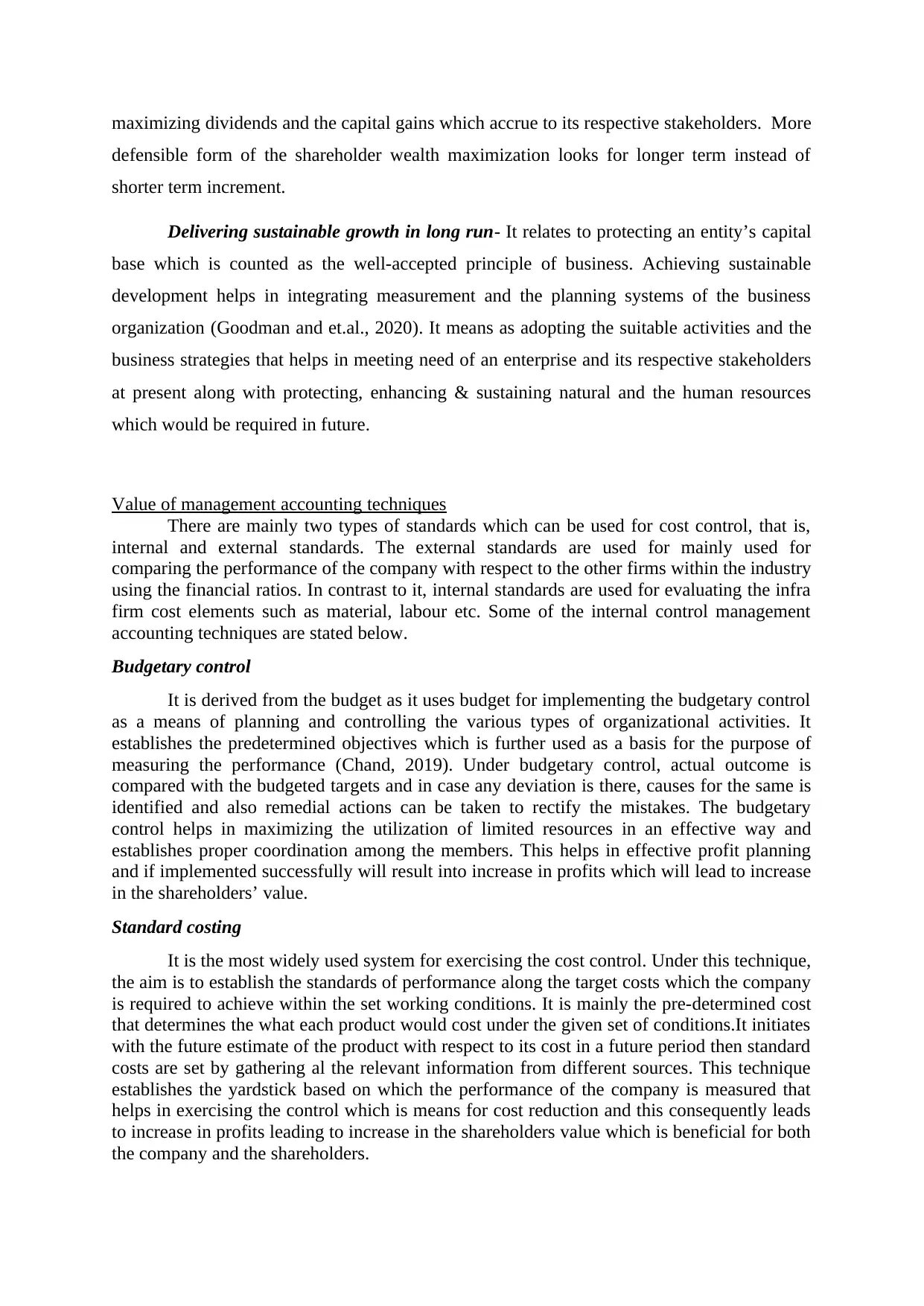
maximizing dividends and the capital gains which accrue to its respective stakeholders. More
defensible form of the shareholder wealth maximization looks for longer term instead of
shorter term increment.
Delivering sustainable growth in long run- It relates to protecting an entity’s capital
base which is counted as the well-accepted principle of business. Achieving sustainable
development helps in integrating measurement and the planning systems of the business
organization (Goodman and et.al., 2020). It means as adopting the suitable activities and the
business strategies that helps in meeting need of an enterprise and its respective stakeholders
at present along with protecting, enhancing & sustaining natural and the human resources
which would be required in future.
Value of management accounting techniques
There are mainly two types of standards which can be used for cost control, that is,
internal and external standards. The external standards are used for mainly used for
comparing the performance of the company with respect to the other firms within the industry
using the financial ratios. In contrast to it, internal standards are used for evaluating the infra
firm cost elements such as material, labour etc. Some of the internal control management
accounting techniques are stated below.
Budgetary control
It is derived from the budget as it uses budget for implementing the budgetary control
as a means of planning and controlling the various types of organizational activities. It
establishes the predetermined objectives which is further used as a basis for the purpose of
measuring the performance (Chand, 2019). Under budgetary control, actual outcome is
compared with the budgeted targets and in case any deviation is there, causes for the same is
identified and also remedial actions can be taken to rectify the mistakes. The budgetary
control helps in maximizing the utilization of limited resources in an effective way and
establishes proper coordination among the members. This helps in effective profit planning
and if implemented successfully will result into increase in profits which will lead to increase
in the shareholders’ value.
Standard costing
It is the most widely used system for exercising the cost control. Under this technique,
the aim is to establish the standards of performance along the target costs which the company
is required to achieve within the set working conditions. It is mainly the pre-determined cost
that determines the what each product would cost under the given set of conditions.It initiates
with the future estimate of the product with respect to its cost in a future period then standard
costs are set by gathering al the relevant information from different sources. This technique
establishes the yardstick based on which the performance of the company is measured that
helps in exercising the control which is means for cost reduction and this consequently leads
to increase in profits leading to increase in the shareholders value which is beneficial for both
the company and the shareholders.
defensible form of the shareholder wealth maximization looks for longer term instead of
shorter term increment.
Delivering sustainable growth in long run- It relates to protecting an entity’s capital
base which is counted as the well-accepted principle of business. Achieving sustainable
development helps in integrating measurement and the planning systems of the business
organization (Goodman and et.al., 2020). It means as adopting the suitable activities and the
business strategies that helps in meeting need of an enterprise and its respective stakeholders
at present along with protecting, enhancing & sustaining natural and the human resources
which would be required in future.
Value of management accounting techniques
There are mainly two types of standards which can be used for cost control, that is,
internal and external standards. The external standards are used for mainly used for
comparing the performance of the company with respect to the other firms within the industry
using the financial ratios. In contrast to it, internal standards are used for evaluating the infra
firm cost elements such as material, labour etc. Some of the internal control management
accounting techniques are stated below.
Budgetary control
It is derived from the budget as it uses budget for implementing the budgetary control
as a means of planning and controlling the various types of organizational activities. It
establishes the predetermined objectives which is further used as a basis for the purpose of
measuring the performance (Chand, 2019). Under budgetary control, actual outcome is
compared with the budgeted targets and in case any deviation is there, causes for the same is
identified and also remedial actions can be taken to rectify the mistakes. The budgetary
control helps in maximizing the utilization of limited resources in an effective way and
establishes proper coordination among the members. This helps in effective profit planning
and if implemented successfully will result into increase in profits which will lead to increase
in the shareholders’ value.
Standard costing
It is the most widely used system for exercising the cost control. Under this technique,
the aim is to establish the standards of performance along the target costs which the company
is required to achieve within the set working conditions. It is mainly the pre-determined cost
that determines the what each product would cost under the given set of conditions.It initiates
with the future estimate of the product with respect to its cost in a future period then standard
costs are set by gathering al the relevant information from different sources. This technique
establishes the yardstick based on which the performance of the company is measured that
helps in exercising the control which is means for cost reduction and this consequently leads
to increase in profits leading to increase in the shareholders value which is beneficial for both
the company and the shareholders.
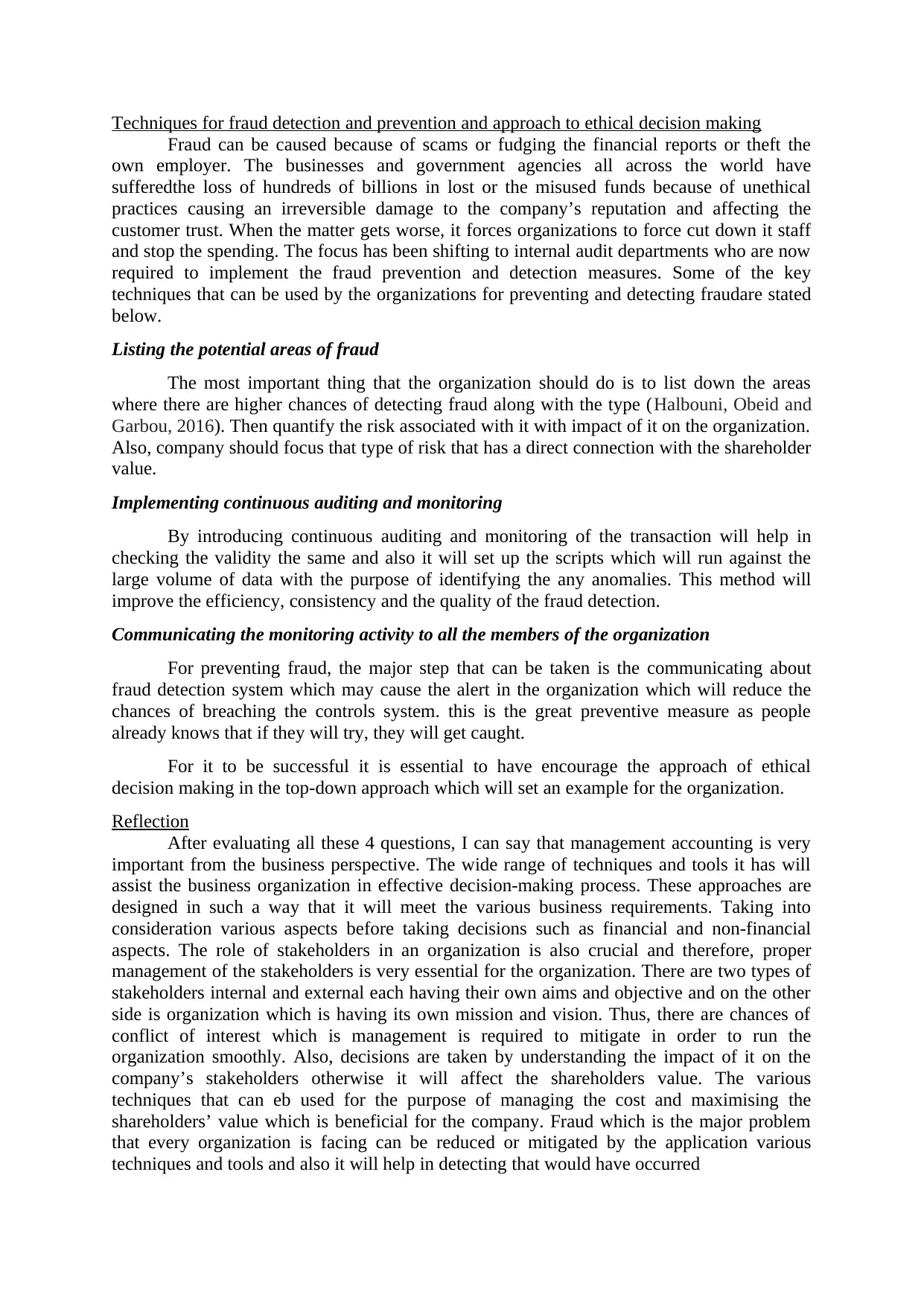
Techniques for fraud detection and prevention and approach to ethical decision making
Fraud can be caused because of scams or fudging the financial reports or theft the
own employer. The businesses and government agencies all across the world have
sufferedthe loss of hundreds of billions in lost or the misused funds because of unethical
practices causing an irreversible damage to the company’s reputation and affecting the
customer trust. When the matter gets worse, it forces organizations to force cut down it staff
and stop the spending. The focus has been shifting to internal audit departments who are now
required to implement the fraud prevention and detection measures. Some of the key
techniques that can be used by the organizations for preventing and detecting fraudare stated
below.
Listing the potential areas of fraud
The most important thing that the organization should do is to list down the areas
where there are higher chances of detecting fraud along with the type (Halbouni, Obeid and
Garbou, 2016). Then quantify the risk associated with it with impact of it on the organization.
Also, company should focus that type of risk that has a direct connection with the shareholder
value.
Implementing continuous auditing and monitoring
By introducing continuous auditing and monitoring of the transaction will help in
checking the validity the same and also it will set up the scripts which will run against the
large volume of data with the purpose of identifying the any anomalies. This method will
improve the efficiency, consistency and the quality of the fraud detection.
Communicating the monitoring activity to all the members of the organization
For preventing fraud, the major step that can be taken is the communicating about
fraud detection system which may cause the alert in the organization which will reduce the
chances of breaching the controls system. this is the great preventive measure as people
already knows that if they will try, they will get caught.
For it to be successful it is essential to have encourage the approach of ethical
decision making in the top-down approach which will set an example for the organization.
Reflection
After evaluating all these 4 questions, I can say that management accounting is very
important from the business perspective. The wide range of techniques and tools it has will
assist the business organization in effective decision-making process. These approaches are
designed in such a way that it will meet the various business requirements. Taking into
consideration various aspects before taking decisions such as financial and non-financial
aspects. The role of stakeholders in an organization is also crucial and therefore, proper
management of the stakeholders is very essential for the organization. There are two types of
stakeholders internal and external each having their own aims and objective and on the other
side is organization which is having its own mission and vision. Thus, there are chances of
conflict of interest which is management is required to mitigate in order to run the
organization smoothly. Also, decisions are taken by understanding the impact of it on the
company’s stakeholders otherwise it will affect the shareholders value. The various
techniques that can eb used for the purpose of managing the cost and maximising the
shareholders’ value which is beneficial for the company. Fraud which is the major problem
that every organization is facing can be reduced or mitigated by the application various
techniques and tools and also it will help in detecting that would have occurred
Fraud can be caused because of scams or fudging the financial reports or theft the
own employer. The businesses and government agencies all across the world have
sufferedthe loss of hundreds of billions in lost or the misused funds because of unethical
practices causing an irreversible damage to the company’s reputation and affecting the
customer trust. When the matter gets worse, it forces organizations to force cut down it staff
and stop the spending. The focus has been shifting to internal audit departments who are now
required to implement the fraud prevention and detection measures. Some of the key
techniques that can be used by the organizations for preventing and detecting fraudare stated
below.
Listing the potential areas of fraud
The most important thing that the organization should do is to list down the areas
where there are higher chances of detecting fraud along with the type (Halbouni, Obeid and
Garbou, 2016). Then quantify the risk associated with it with impact of it on the organization.
Also, company should focus that type of risk that has a direct connection with the shareholder
value.
Implementing continuous auditing and monitoring
By introducing continuous auditing and monitoring of the transaction will help in
checking the validity the same and also it will set up the scripts which will run against the
large volume of data with the purpose of identifying the any anomalies. This method will
improve the efficiency, consistency and the quality of the fraud detection.
Communicating the monitoring activity to all the members of the organization
For preventing fraud, the major step that can be taken is the communicating about
fraud detection system which may cause the alert in the organization which will reduce the
chances of breaching the controls system. this is the great preventive measure as people
already knows that if they will try, they will get caught.
For it to be successful it is essential to have encourage the approach of ethical
decision making in the top-down approach which will set an example for the organization.
Reflection
After evaluating all these 4 questions, I can say that management accounting is very
important from the business perspective. The wide range of techniques and tools it has will
assist the business organization in effective decision-making process. These approaches are
designed in such a way that it will meet the various business requirements. Taking into
consideration various aspects before taking decisions such as financial and non-financial
aspects. The role of stakeholders in an organization is also crucial and therefore, proper
management of the stakeholders is very essential for the organization. There are two types of
stakeholders internal and external each having their own aims and objective and on the other
side is organization which is having its own mission and vision. Thus, there are chances of
conflict of interest which is management is required to mitigate in order to run the
organization smoothly. Also, decisions are taken by understanding the impact of it on the
company’s stakeholders otherwise it will affect the shareholders value. The various
techniques that can eb used for the purpose of managing the cost and maximising the
shareholders’ value which is beneficial for the company. Fraud which is the major problem
that every organization is facing can be reduced or mitigated by the application various
techniques and tools and also it will help in detecting that would have occurred
⊘ This is a preview!⊘
Do you want full access?
Subscribe today to unlock all pages.

Trusted by 1+ million students worldwide
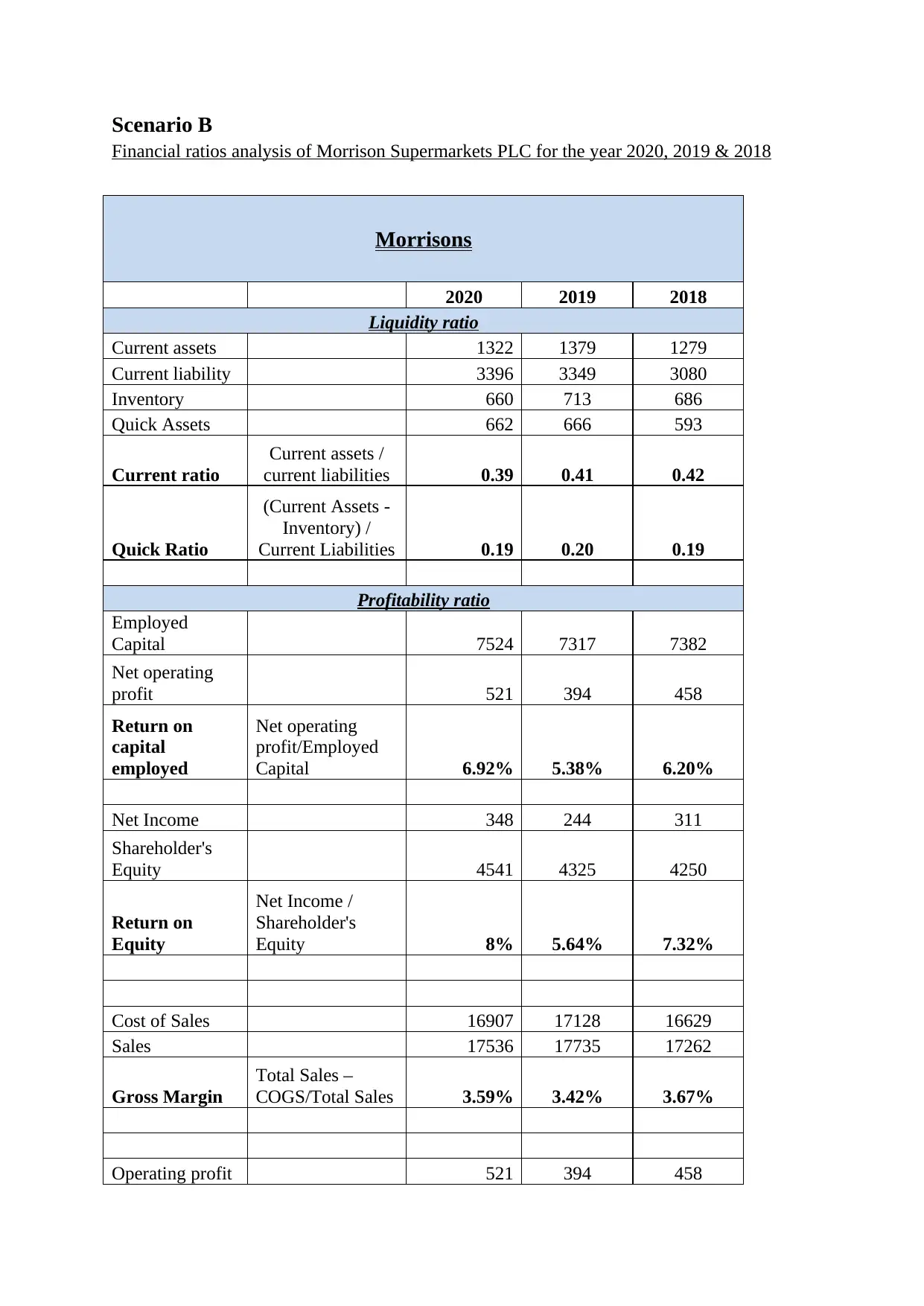
Scenario B
Financial ratios analysis of Morrison Supermarkets PLC for the year 2020, 2019 & 2018
Morrisons
2020 2019 2018
Liquidity ratio
Current assets 1322 1379 1279
Current liability 3396 3349 3080
Inventory 660 713 686
Quick Assets 662 666 593
Current ratio
Current assets /
current liabilities 0.39 0.41 0.42
Quick Ratio
(Current Assets -
Inventory) /
Current Liabilities 0.19 0.20 0.19
Profitability ratio
Employed
Capital 7524 7317 7382
Net operating
profit 521 394 458
Return on
capital
employed
Net operating
profit/Employed
Capital 6.92% 5.38% 6.20%
Net Income 348 244 311
Shareholder's
Equity 4541 4325 4250
Return on
Equity
Net Income /
Shareholder's
Equity 8% 5.64% 7.32%
Cost of Sales 16907 17128 16629
Sales 17536 17735 17262
Gross Margin
Total Sales –
COGS/Total Sales 3.59% 3.42% 3.67%
Operating profit 521 394 458
Financial ratios analysis of Morrison Supermarkets PLC for the year 2020, 2019 & 2018
Morrisons
2020 2019 2018
Liquidity ratio
Current assets 1322 1379 1279
Current liability 3396 3349 3080
Inventory 660 713 686
Quick Assets 662 666 593
Current ratio
Current assets /
current liabilities 0.39 0.41 0.42
Quick Ratio
(Current Assets -
Inventory) /
Current Liabilities 0.19 0.20 0.19
Profitability ratio
Employed
Capital 7524 7317 7382
Net operating
profit 521 394 458
Return on
capital
employed
Net operating
profit/Employed
Capital 6.92% 5.38% 6.20%
Net Income 348 244 311
Shareholder's
Equity 4541 4325 4250
Return on
Equity
Net Income /
Shareholder's
Equity 8% 5.64% 7.32%
Cost of Sales 16907 17128 16629
Sales 17536 17735 17262
Gross Margin
Total Sales –
COGS/Total Sales 3.59% 3.42% 3.67%
Operating profit 521 394 458
Paraphrase This Document
Need a fresh take? Get an instant paraphrase of this document with our AI Paraphraser
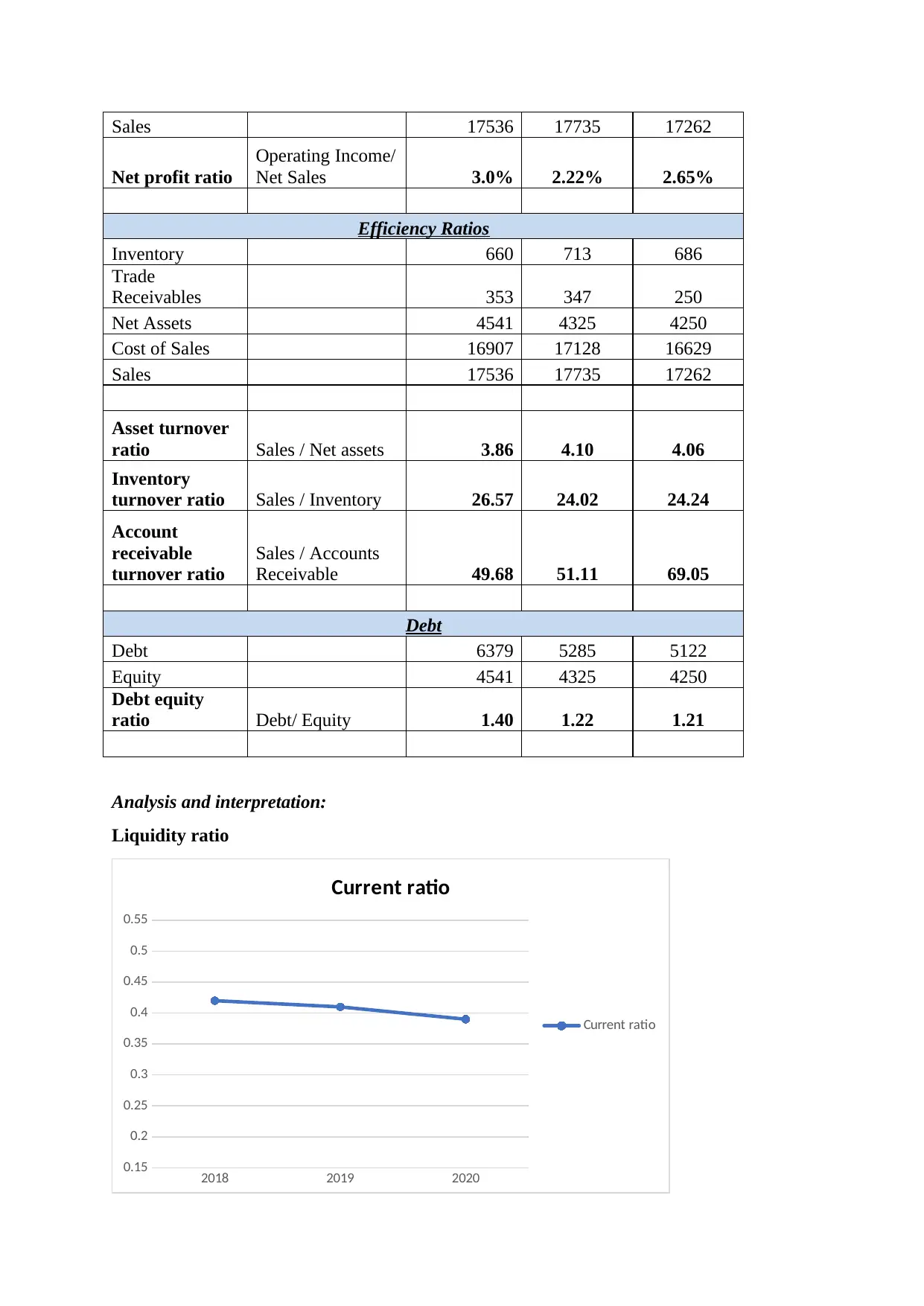
Sales 17536 17735 17262
Net profit ratio
Operating Income/
Net Sales 3.0% 2.22% 2.65%
Efficiency Ratios
Inventory 660 713 686
Trade
Receivables 353 347 250
Net Assets 4541 4325 4250
Cost of Sales 16907 17128 16629
Sales 17536 17735 17262
Asset turnover
ratio Sales / Net assets 3.86 4.10 4.06
Inventory
turnover ratio Sales / Inventory 26.57 24.02 24.24
Account
receivable
turnover ratio
Sales / Accounts
Receivable 49.68 51.11 69.05
Debt
Debt 6379 5285 5122
Equity 4541 4325 4250
Debt equity
ratio Debt/ Equity 1.40 1.22 1.21
Analysis and interpretation:
Liquidity ratio
2018 2019 2020
0.15
0.2
0.25
0.3
0.35
0.4
0.45
0.5
0.55
Current ratio
Current ratio
Net profit ratio
Operating Income/
Net Sales 3.0% 2.22% 2.65%
Efficiency Ratios
Inventory 660 713 686
Trade
Receivables 353 347 250
Net Assets 4541 4325 4250
Cost of Sales 16907 17128 16629
Sales 17536 17735 17262
Asset turnover
ratio Sales / Net assets 3.86 4.10 4.06
Inventory
turnover ratio Sales / Inventory 26.57 24.02 24.24
Account
receivable
turnover ratio
Sales / Accounts
Receivable 49.68 51.11 69.05
Debt
Debt 6379 5285 5122
Equity 4541 4325 4250
Debt equity
ratio Debt/ Equity 1.40 1.22 1.21
Analysis and interpretation:
Liquidity ratio
2018 2019 2020
0.15
0.2
0.25
0.3
0.35
0.4
0.45
0.5
0.55
Current ratio
Current ratio
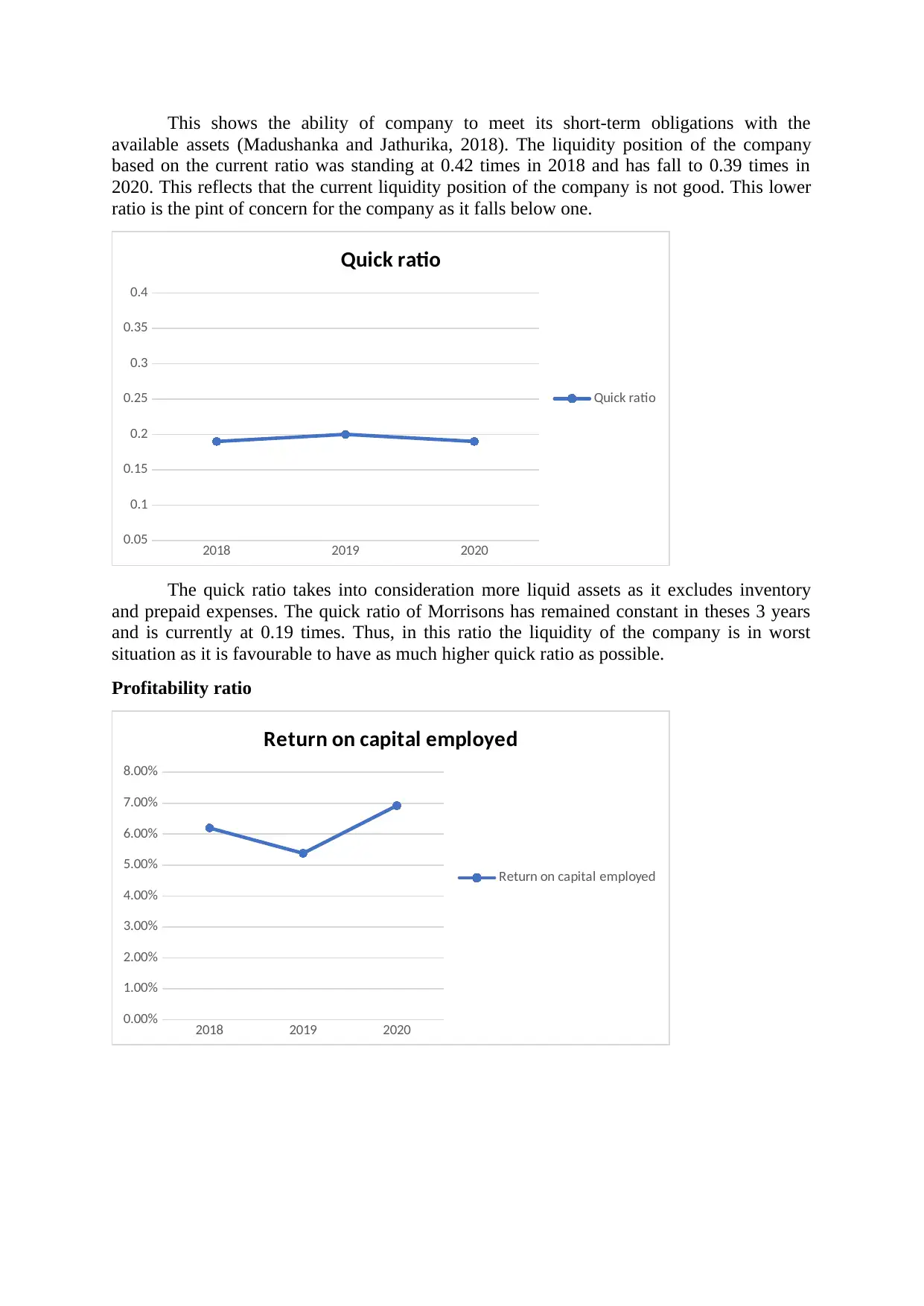
This shows the ability of company to meet its short-term obligations with the
available assets (Madushanka and Jathurika, 2018). The liquidity position of the company
based on the current ratio was standing at 0.42 times in 2018 and has fall to 0.39 times in
2020. This reflects that the current liquidity position of the company is not good. This lower
ratio is the pint of concern for the company as it falls below one.
2018 2019 2020
0.05
0.1
0.15
0.2
0.25
0.3
0.35
0.4
Quick ratio
Quick ratio
The quick ratio takes into consideration more liquid assets as it excludes inventory
and prepaid expenses. The quick ratio of Morrisons has remained constant in theses 3 years
and is currently at 0.19 times. Thus, in this ratio the liquidity of the company is in worst
situation as it is favourable to have as much higher quick ratio as possible.
Profitability ratio
2018 2019 2020
0.00%
1.00%
2.00%
3.00%
4.00%
5.00%
6.00%
7.00%
8.00%
Return on capital employed
Return on capital employed
available assets (Madushanka and Jathurika, 2018). The liquidity position of the company
based on the current ratio was standing at 0.42 times in 2018 and has fall to 0.39 times in
2020. This reflects that the current liquidity position of the company is not good. This lower
ratio is the pint of concern for the company as it falls below one.
2018 2019 2020
0.05
0.1
0.15
0.2
0.25
0.3
0.35
0.4
Quick ratio
Quick ratio
The quick ratio takes into consideration more liquid assets as it excludes inventory
and prepaid expenses. The quick ratio of Morrisons has remained constant in theses 3 years
and is currently at 0.19 times. Thus, in this ratio the liquidity of the company is in worst
situation as it is favourable to have as much higher quick ratio as possible.
Profitability ratio
2018 2019 2020
0.00%
1.00%
2.00%
3.00%
4.00%
5.00%
6.00%
7.00%
8.00%
Return on capital employed
Return on capital employed
⊘ This is a preview!⊘
Do you want full access?
Subscribe today to unlock all pages.

Trusted by 1+ million students worldwide
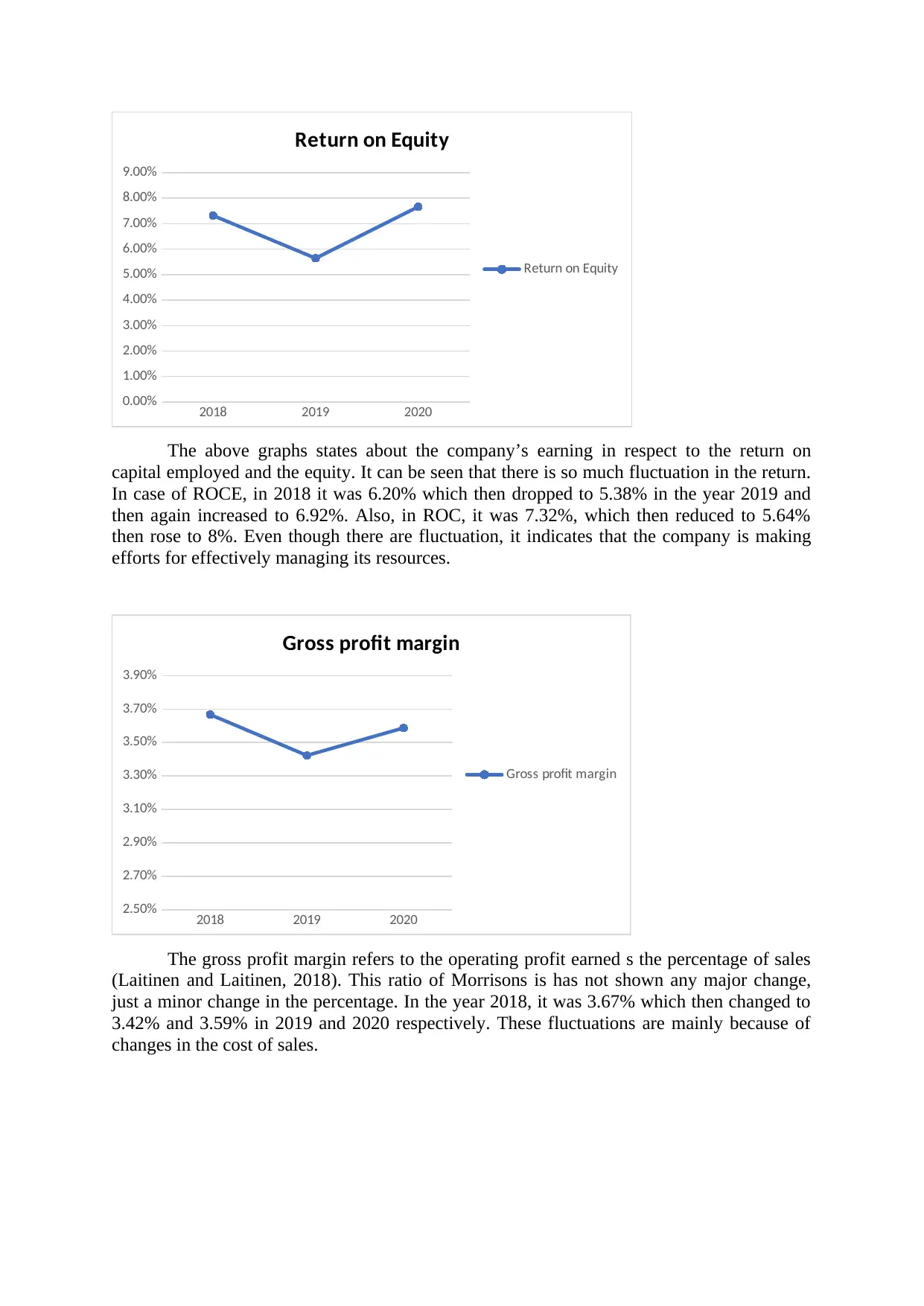
2018 2019 2020
0.00%
1.00%
2.00%
3.00%
4.00%
5.00%
6.00%
7.00%
8.00%
9.00%
Return on Equity
Return on Equity
The above graphs states about the company’s earning in respect to the return on
capital employed and the equity. It can be seen that there is so much fluctuation in the return.
In case of ROCE, in 2018 it was 6.20% which then dropped to 5.38% in the year 2019 and
then again increased to 6.92%. Also, in ROC, it was 7.32%, which then reduced to 5.64%
then rose to 8%. Even though there are fluctuation, it indicates that the company is making
efforts for effectively managing its resources.
2018 2019 2020
2.50%
2.70%
2.90%
3.10%
3.30%
3.50%
3.70%
3.90%
Gross profit margin
Gross profit margin
The gross profit margin refers to the operating profit earned s the percentage of sales
(Laitinen and Laitinen, 2018). This ratio of Morrisons is has not shown any major change,
just a minor change in the percentage. In the year 2018, it was 3.67% which then changed to
3.42% and 3.59% in 2019 and 2020 respectively. These fluctuations are mainly because of
changes in the cost of sales.
0.00%
1.00%
2.00%
3.00%
4.00%
5.00%
6.00%
7.00%
8.00%
9.00%
Return on Equity
Return on Equity
The above graphs states about the company’s earning in respect to the return on
capital employed and the equity. It can be seen that there is so much fluctuation in the return.
In case of ROCE, in 2018 it was 6.20% which then dropped to 5.38% in the year 2019 and
then again increased to 6.92%. Also, in ROC, it was 7.32%, which then reduced to 5.64%
then rose to 8%. Even though there are fluctuation, it indicates that the company is making
efforts for effectively managing its resources.
2018 2019 2020
2.50%
2.70%
2.90%
3.10%
3.30%
3.50%
3.70%
3.90%
Gross profit margin
Gross profit margin
The gross profit margin refers to the operating profit earned s the percentage of sales
(Laitinen and Laitinen, 2018). This ratio of Morrisons is has not shown any major change,
just a minor change in the percentage. In the year 2018, it was 3.67% which then changed to
3.42% and 3.59% in 2019 and 2020 respectively. These fluctuations are mainly because of
changes in the cost of sales.
Paraphrase This Document
Need a fresh take? Get an instant paraphrase of this document with our AI Paraphraser
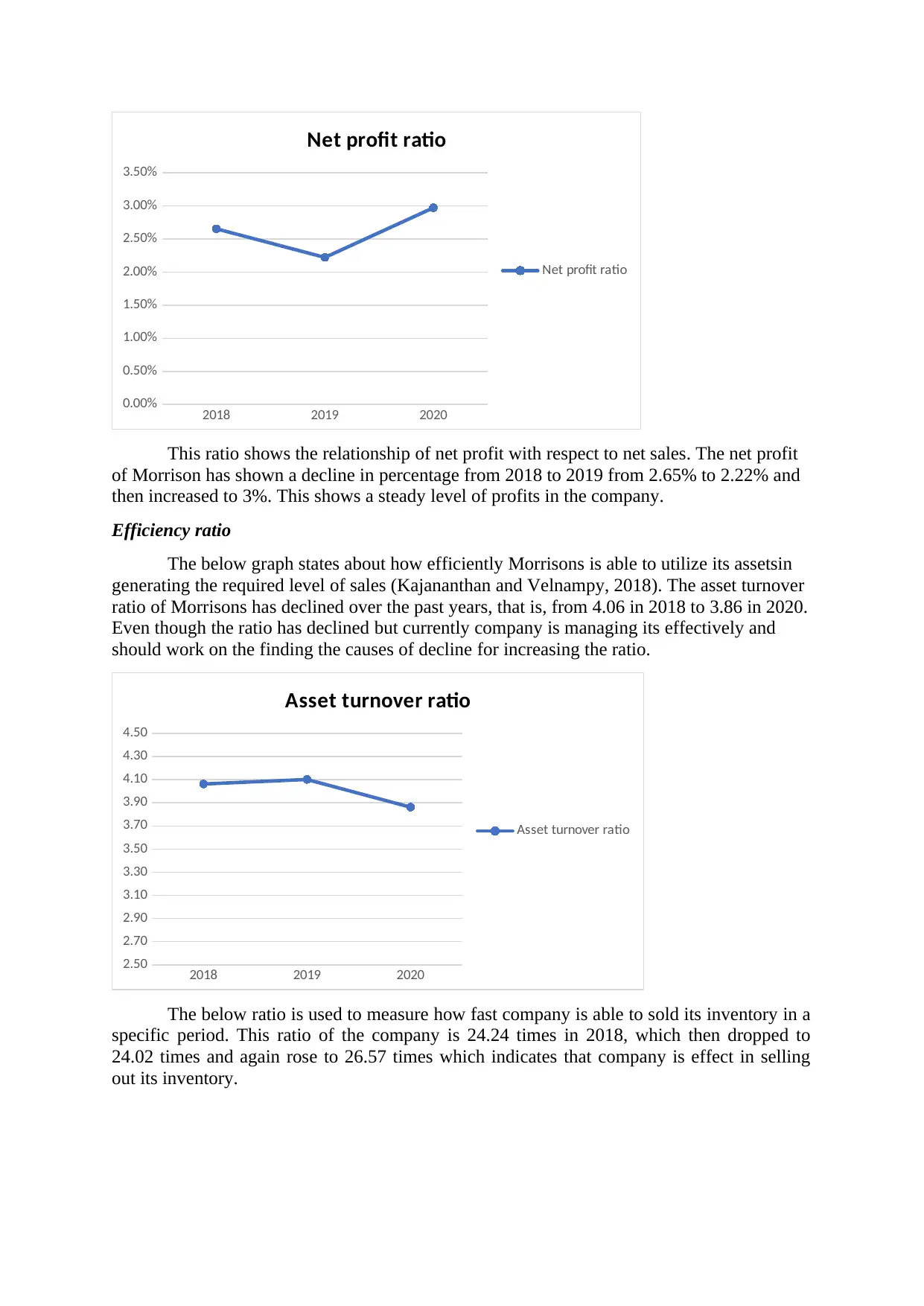
2018 2019 2020
0.00%
0.50%
1.00%
1.50%
2.00%
2.50%
3.00%
3.50%
Net profit ratio
Net profit ratio
This ratio shows the relationship of net profit with respect to net sales. The net profit
of Morrison has shown a decline in percentage from 2018 to 2019 from 2.65% to 2.22% and
then increased to 3%. This shows a steady level of profits in the company.
Efficiency ratio
The below graph states about how efficiently Morrisons is able to utilize its assetsin
generating the required level of sales (Kajananthan and Velnampy, 2018). The asset turnover
ratio of Morrisons has declined over the past years, that is, from 4.06 in 2018 to 3.86 in 2020.
Even though the ratio has declined but currently company is managing its effectively and
should work on the finding the causes of decline for increasing the ratio.
2018 2019 2020
2.50
2.70
2.90
3.10
3.30
3.50
3.70
3.90
4.10
4.30
4.50
Asset turnover ratio
Asset turnover ratio
The below ratio is used to measure how fast company is able to sold its inventory in a
specific period. This ratio of the company is 24.24 times in 2018, which then dropped to
24.02 times and again rose to 26.57 times which indicates that company is effect in selling
out its inventory.
0.00%
0.50%
1.00%
1.50%
2.00%
2.50%
3.00%
3.50%
Net profit ratio
Net profit ratio
This ratio shows the relationship of net profit with respect to net sales. The net profit
of Morrison has shown a decline in percentage from 2018 to 2019 from 2.65% to 2.22% and
then increased to 3%. This shows a steady level of profits in the company.
Efficiency ratio
The below graph states about how efficiently Morrisons is able to utilize its assetsin
generating the required level of sales (Kajananthan and Velnampy, 2018). The asset turnover
ratio of Morrisons has declined over the past years, that is, from 4.06 in 2018 to 3.86 in 2020.
Even though the ratio has declined but currently company is managing its effectively and
should work on the finding the causes of decline for increasing the ratio.
2018 2019 2020
2.50
2.70
2.90
3.10
3.30
3.50
3.70
3.90
4.10
4.30
4.50
Asset turnover ratio
Asset turnover ratio
The below ratio is used to measure how fast company is able to sold its inventory in a
specific period. This ratio of the company is 24.24 times in 2018, which then dropped to
24.02 times and again rose to 26.57 times which indicates that company is effect in selling
out its inventory.
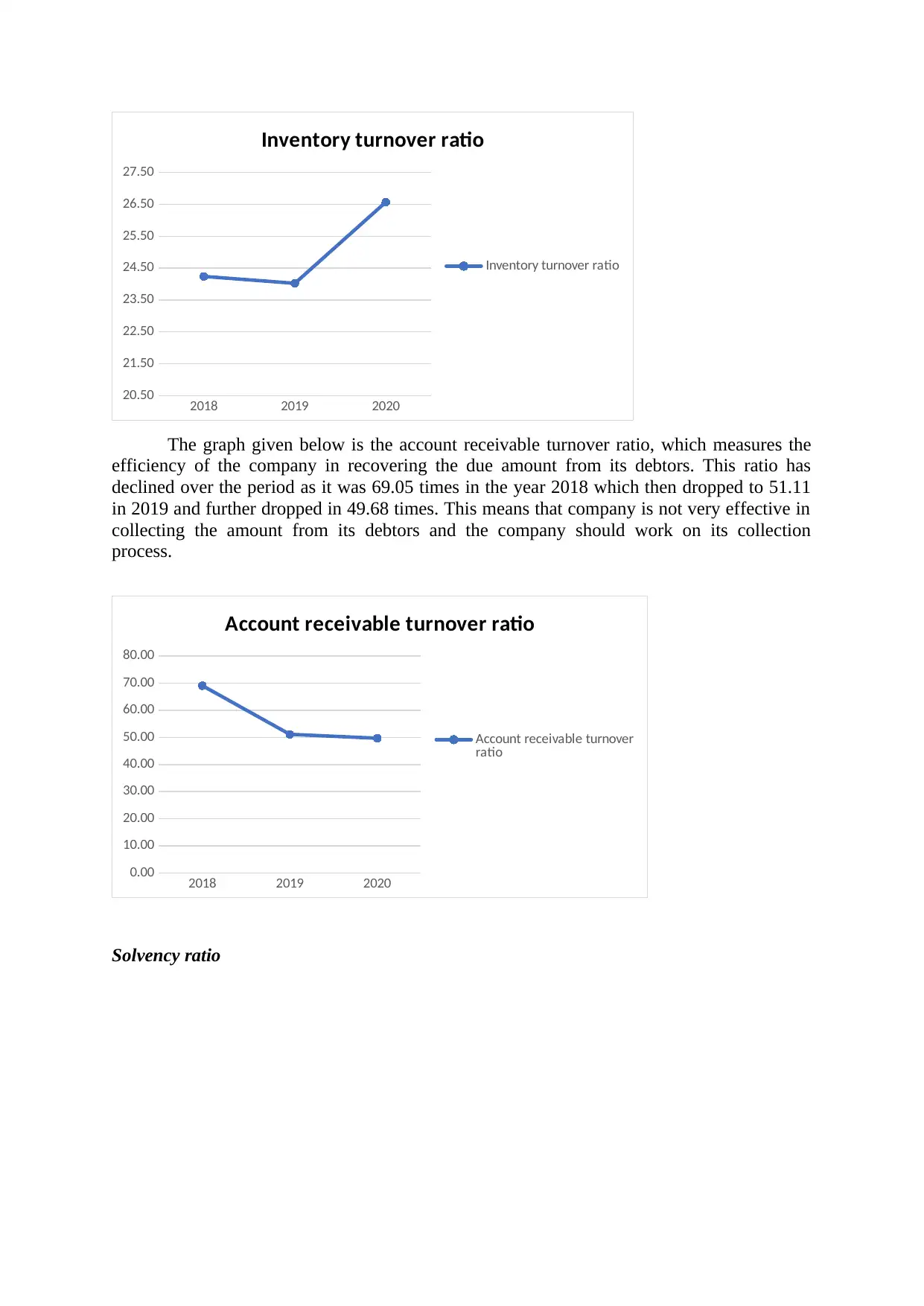
2018 2019 2020
20.50
21.50
22.50
23.50
24.50
25.50
26.50
27.50
Inventory turnover ratio
Inventory turnover ratio
The graph given below is the account receivable turnover ratio, which measures the
efficiency of the company in recovering the due amount from its debtors. This ratio has
declined over the period as it was 69.05 times in the year 2018 which then dropped to 51.11
in 2019 and further dropped in 49.68 times. This means that company is not very effective in
collecting the amount from its debtors and the company should work on its collection
process.
2018 2019 2020
0.00
10.00
20.00
30.00
40.00
50.00
60.00
70.00
80.00
Account receivable turnover ratio
Account receivable turnover
ratio
Solvency ratio
20.50
21.50
22.50
23.50
24.50
25.50
26.50
27.50
Inventory turnover ratio
Inventory turnover ratio
The graph given below is the account receivable turnover ratio, which measures the
efficiency of the company in recovering the due amount from its debtors. This ratio has
declined over the period as it was 69.05 times in the year 2018 which then dropped to 51.11
in 2019 and further dropped in 49.68 times. This means that company is not very effective in
collecting the amount from its debtors and the company should work on its collection
process.
2018 2019 2020
0.00
10.00
20.00
30.00
40.00
50.00
60.00
70.00
80.00
Account receivable turnover ratio
Account receivable turnover
ratio
Solvency ratio
⊘ This is a preview!⊘
Do you want full access?
Subscribe today to unlock all pages.

Trusted by 1+ million students worldwide
1 out of 20
Related Documents
Your All-in-One AI-Powered Toolkit for Academic Success.
+13062052269
info@desklib.com
Available 24*7 on WhatsApp / Email
![[object Object]](/_next/static/media/star-bottom.7253800d.svg)
Unlock your academic potential
Copyright © 2020–2025 A2Z Services. All Rights Reserved. Developed and managed by ZUCOL.





